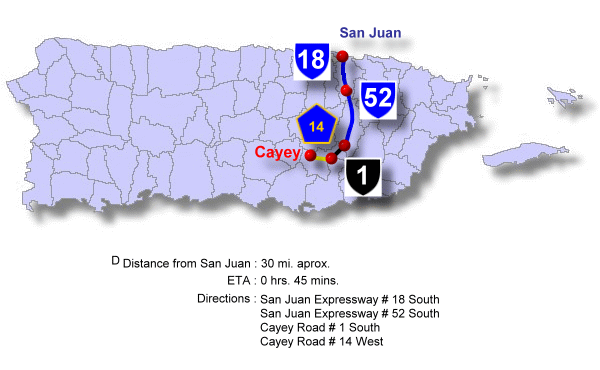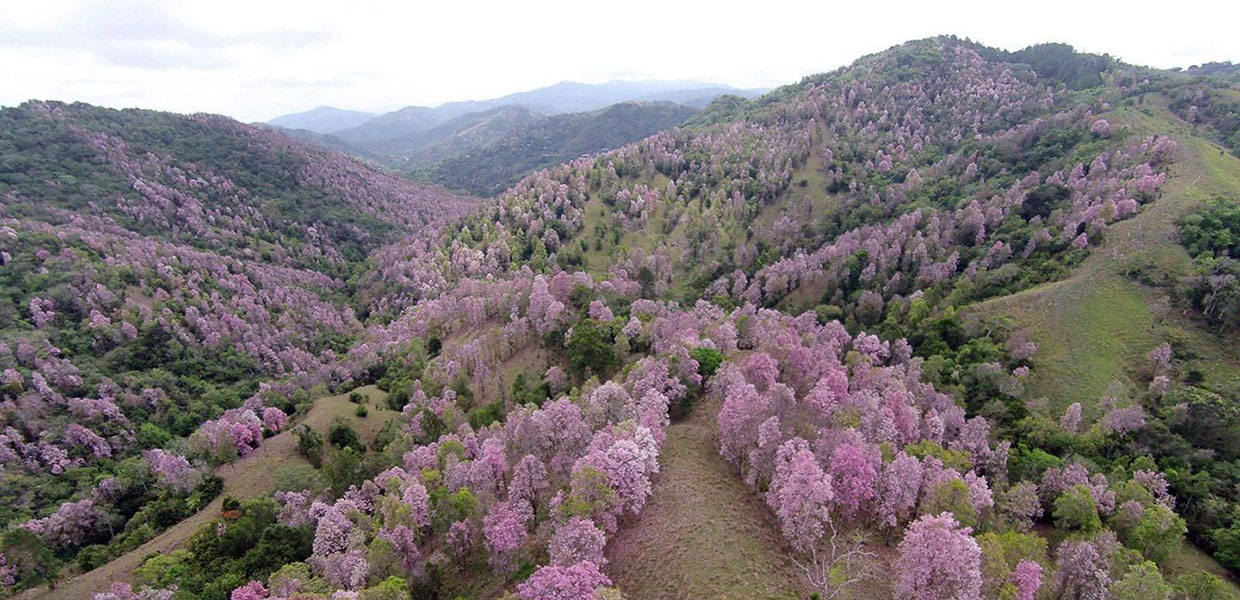
Cayey, Puerto Rico
Mist City
 Cayey (kei-YAI) is affectionately known as the City of the Mists, the City of the Little Bull, and the City of the Golden Coquí. Its Patron Saint is Our Lady of the Assumption, and the traditional Patron Saint Festivities are celebrated every August, bringing together residents and visitors in an atmosphere filled with music, culture, and devotion.
Cayey (kei-YAI) is affectionately known as the City of the Mists, the City of the Little Bull, and the City of the Golden Coquí. Its Patron Saint is Our Lady of the Assumption, and the traditional Patron Saint Festivities are celebrated every August, bringing together residents and visitors in an atmosphere filled with music, culture, and devotion.
Located in the heart of the Central Mountain Range, Cayey is distinguished by its cool climate and mountains that overlook Puerto Rico’s southern coast. It borders Cidra and Caguas to the north; Salinas and Guayama to the south; Caguas, San Lorenzo, and Patillas to the east; and Aibonito and Salinas to the west.
Gastronomy, Culture, and Nature
One of Cayey’s greatest attractions is Guavate, home to part of the Carite State Forest and world-famous for the renowned Ruta del Lechón (Pork Highway). This vibrant area comes alive on weekends with traditional music, lechoneras, restaurants, and food kiosks where visitors enjoy some of the best flavors of Puerto Rican cuisine. It is a beloved gathering place for families and tourists seeking an authentic cultural experience on the Island.
Along Road 184 you will also find the Los Tres Santos Reyes Recreational Park, a venue for festivals, bohemian nights, and local craft fairs. Throughout the route, nearly 15 cultural sculptures created by artist Juan Santos, together with Héctor León and Gladys Nieves, add artistic beauty to the landscape.
Amid the majestic scenery of Jájome stands the Summer Residence of the Governors of Puerto Rico, a historic structure nestled among mountains and lush nature.
Center of History and Education
Cayey also stands out for its cultural and historical offerings. It is home to the University of Puerto Rico at Cayey (UPR Cayey), several museums, and the iconic Muñoz-Mendoza House, the residence of former Governor Luis Muñoz Marín and Inés Mendoza after his term in office, now preserved as an important heritage site.
Foundation and History of Cayey
A Town Forged Among Mountains, Tradition, and Historic Roads
The origins of Cayey trace back to the ancient Taíno settlement of Toíta, an indigenous community established near the course of the Río de la Plata. Although the name “Cayey” appears in documents as early as the 16th century, its written form evolved over the years, reflecting changes in language and Spanish interpretations of indigenous names. It is believed that the name comes from the chief who ruled the area before colonization.
During the colonial period, the area was part of the Hato de Cayey, under the jurisdiction of the Coamo district. As the population grew and locals sought to establish an urban center of their own, the residents of Toíta requested the creation of a town in 1773. The petition was promptly approved by Governor Miguel de Muesas, and on August 17, 1773, the municipality was officially founded under the name Nuestra Señora de la Asunción de Cayey de Muesas.
A Humble Beginning
The early years of Cayey were modest: just a few houses, a wooden church, and a community primarily dedicated to livestock and basic agriculture. Although the area was fertile and rich in natural resources, the population lived simply, consuming only what was necessary to sustain itself.
Immigration and Cultural Mixing
In the early 19th century, the municipality underwent significant changes. Areas such as Cidra began the process of administrative separation, while new waves of immigrants from Catalonia, Galicia, the Canary Islands, and France settled in the valley. These families blended with the local Criollo population, leaving a notable cultural imprint on surnames, customs, and the local economy.
The Coffee Boom and 19th-Century Transformation
By the mid-19th century, Cayey became a prominent coffee producer. The cool climate of the central mountains and fertile lands allowed the establishment of coffee farms that boosted the local economy.
This growth coincided with the construction of new roads connecting Cayey to much of the island. Roads to Caguas, Ponce, Cidra, Aibonito, and Arroyo—some built with advanced engineering techniques for the time—strengthened its position as a strategic transportation hub. The expansion of roads turned Cayey into a central link between northern, southern, and eastern Puerto Rico.
A Municipality of Strategic Importance
The 19th-century road network not only facilitated trade but also laid the foundations for economic development throughout the 20th century. Thanks to its location and climate, Cayey became attractive for industries, educational institutions, and summer residences, including the governor’s residence in Jájome.
Cayey Today
Today, Cayey continues to stand out for its cool climate, cultural richness, and strategic location in the central mountains. With a modern population that retains pride in its historical roots, the municipality blends tradition with development, preserving its indigenous, Spanish, and Criollo heritage.
Location
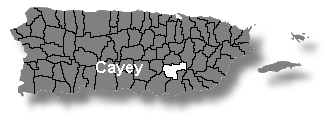 Cayey is located in the central mountainous region of Puerto Rico, specifically in the Sierra de Cayey, overlooking the southern coast. Its elevation provides a cooler, more humid climate, often creating morning mists, which is why it is known as the “City of the Mists.”
Cayey is located in the central mountainous region of Puerto Rico, specifically in the Sierra de Cayey, overlooking the southern coast. Its elevation provides a cooler, more humid climate, often creating morning mists, which is why it is known as the “City of the Mists.”
Geographic Boundaries:
- North: Cidra and Caguas
- South: Salinas and Guayama
- East: Caguas and San Lorenzo
- West: Aibonito and Salinas
Its central mountain location allows Cayey to serve as a connection point between the north and south, as well as with the eastern region of the island.
Area and Elevation
- Total area: approximately 130 km² (50 mi²)
- Elevation: The urban center sits around 400 meters above sea level, with higher points in the surrounding sierras. This contributes to a mild and cool climate, ideal for agriculture and mountain tourism.
Population and Density
- 2000 Census: 47,370 inhabitants
- 2020 Census: approximately 41,652 inhabitants
- Population density: about 320 inhabitants/km², reflecting a moderate decline in recent decades due to migration toward metropolitan areas
Demonym
Cayeyanos
Nicknames
- City of the Mists
- City of the Little Bull
- City of the Golden Coquí
Connectivity and Access
Cayey is crossed by major highways such as PR‑52 and PR‑1, facilitating travel to San Juan, Ponce, and other central and southern regions. This road network has been vital for commerce, transport of agricultural products, and tourism, especially to areas like Guavate and Jájome.
Barrios of Cayey, Puerto Rico
The municipality is divided into multiple barrios, reflecting its geographic, cultural, and economic diversity. From the urban center to surrounding mountains and valleys, each barrio has its own identity and contributes to Cayey’s unique character.
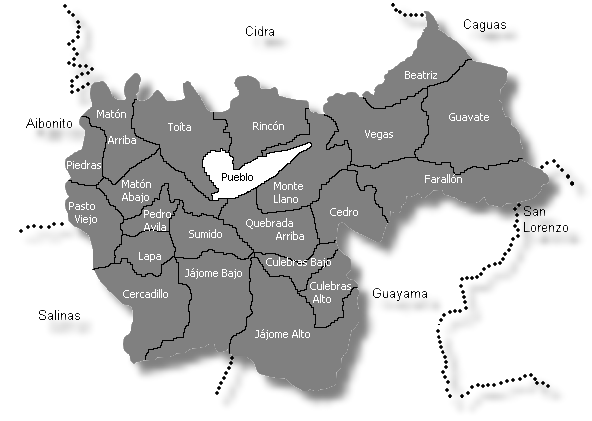
| Census 2020: Population by Barrios - Cayey |
Approx. Population |
| Beatriz | 1,800 |
| Cayey Pueblo | 14,500 |
| Cedro | 750 |
| Cercadillo | 800 |
| Culebras Alto | 65 |
| Culebras Bajo | 280 |
| Farallón | 600 |
| Guavate | 1,450 |
| Jájome Alto | 640 |
| Jájome Bajo | 620 |
| Lapa | 230 |
| Matón Abajo | 1,150 |
| Matón Arriba | 1,000 |
| Monte Llano | 3,800 |
| Pasto Viejo | 640 |
| Pedro Ávila | 170 |
| Piedras | 55 |
| Quebrada Arriba | 1,100 |
| Rincón | 5,800 |
| Sumido | 720 |
| Toíta | 6,200 |
| Vegas | 3,000 |
| Total Approx. | 41,652 |
Source: US Censo
Key Barrio Highlights
- Cayey Pueblo: Historical and administrative center, including municipal offices, the main plaza, and the church of Nuestra Señora de la Asunción
- Guavate: Renowned for the Ruta del Lechón, a culinary and cultural destination
- Jájome and Monte Llano: High-altitude barrios with scenic landscapes and summer residences, including the historic governor’s mansion
- Vegas and Toíta: Rural areas with strong agricultural traditions and local celebrations
Patron Saint
Parish: Nuestra Señora de la Asunción
Address: P.O. Box 372887, Cayey, PR 00737-2887
Phone: (787) 738-2763
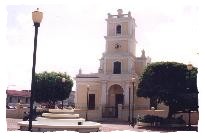
The patron saint of Cayey is Our Lady of the Assumption, celebrated each August with religious and cultural activities attracting both locals and visitors. The church is an architectural and cultural icon, central to the town’s religious and patronal festivities.
Topography and Hydrography
Topography:
Cayey’s terrain is predominantly mountainous, encompassing the Sierras de Cayey and Jájome, part of Puerto Rico’s Central Mountain Range. High areas offer panoramic views of the valley and southern coast, contributing to its cool, misty climate. Lower valley areas host the population, commerce, and municipal services, supporting agriculture and tourism.
Hydrography:
The municipality is fed by rivers and streams:
- Rivers flowing to the Atlantic Ocean: Río de la Plata, Río Chiquito, Río Guavate, Río Matón
- Rivers flowing to the Caribbean Sea: Río Majada, Río Jájome, Río Lapa
These water sources are crucial for agriculture, biodiversity, and recreational activities, including eco-tours in protected natural areas.
Predominant Industries
Cayey’s economy combines traditional and modern sectors:
- Manufacturing: Food products, pharmaceuticals, medical equipment
- Agriculture: Livestock and mountain crops
- Telecommunications and services
Average Weekly Salary: $327.70 (1998; modern figures reflect inflation and economic changes).
Flag of Cayey
 The flag of Cayey has a unique design that reflects the identity and history of the municipality.
The flag of Cayey has a unique design that reflects the identity and history of the municipality.
It is composed of four triangles converging toward the center, two in white and two in red, with the municipal coat of arms at the center. The colors symbolize purity, courage, and historical heritage, representing both the Spanish tradition and the spirit of the Cayey community.
Coat of Arms of Cayey
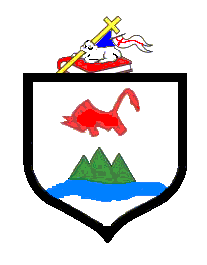 The municipal coat of arms of Cayey is rich in symbols that reflect the town’s geography, history, and culture:
The municipal coat of arms of Cayey is rich in symbols that reflect the town’s geography, history, and culture:
- A three-peaked mountain, representing the Sierras de Cayey and Jájome.
- A red bull (“toro de gules”), symbolizing strength and the municipality’s livestock tradition.
- A blue wavy band, representing the abundance of water in the region and honoring the town’s original patroness.
- On the timbre, there is a silver Paschal Lamb, bearing the symbol of San Juan de Puerto Rico, on a closed red book, representing faith, knowledge, and culture.
Meaning of the Colors:
- Red and Gold: Spanish tradition and respect for the founder
- Green: The landscapes and mountains of Cayey
- Black: Antiquity, solemnity, and seriousness
The coat of arms was created by Dr. J.J. Santa Pinter, Associate Professor at the University College of Cayey, and has become an official symbol representing the cultural and historical identity of the municipality.
Places of Interest in Cayey
Cayey offers a variety of cultural, historical, and natural attractions, making it a unique destination on the island:
- Guavate “La Ruta del Lechón”: Famous for its lechoneras and restaurants, offering traditional Puerto Rican dishes accompanied by music and local traditions.
- Carite State Forest (Bosque Estatal de Carite): A protected area ideal for hiking, birdwatching, and connecting with nature.
- Town Hall (Casa Alcaldía): The municipal government seat and an example of local historical architecture.
- House of Stories and Cayey History (Casa del Cuento y de la Historia Cayeyana): Museum preserving the memory and traditions of the municipality.
- Casilla del Caminero: Historical heritage site related to the construction and maintenance of roads.
- Cayey Seismological Center (Centro Sismológico de Cayey): Monitors seismic activity in Puerto Rico.
- Cerro El Torito: Iconic hill offering panoramic views of the Cayey valley.
- Luis Raúl “El Rolo” Colón Municipal Sports Complex: Facilities for sports and recreational activities.
- Cayey School of Fine Arts (Escuela de Bellas Artes de Cayey): Space dedicated to artistic and cultural development.
- Garita de Cayey (Tetas): Historical lookout point known for its distinctive shape.
- Rex Cream Ice Cream Parlor: Traditional local ice cream shop popular among residents and visitors.
- Church of Our Lady of the Assumption (Iglesia Nuestra Señora de la Asunción): Religious and cultural center, host of the patron saint festivities.
- Monument to the Jíbaro (Monumento al Jíbaro): Tribute to the emblematic Puerto Rican farmer.
- Monument to the Kings and Los Tres Santos Reyes Recreational Park: Venue for festivals, fairs, and family activities.
- Veterans Monument (Monumento al Veterano): Honors citizens who served Puerto Rico and the United States.
- Dr. Pío López Martínez Art Museum: Exhibits of local and international art.
- Ibero-American Promenade (Paseo Iberoamericano): Space celebrating the history and culture of the Ibero-American region.
- Ramón Frade Recreation Plaza (Plaza de Recreo Ramón Frade): Social and cultural meeting point in downtown Cayey.
- Cayey Sports Hall of Fame (Salón de la Fama del Deporte Cayeyano): Recognizes outstanding athletes from the municipality.
Events and Festivals
Cayey maintains an active cultural and recreational calendar, with festivals and celebrations throughout the year:
- Festival of the Child and the Mountain – January
- Regional Fair – April
- Olimpiadas del Torito – April
- Oak Festival (Festival del Roble) – June
- Recognition of Distinguished Youth – June
- Constitution Night – July
- Patron Saint Festivities of Our Lady of the Assumption – August
- San Isidro Labrador Festival – October
- Christmas Festival – December
- River Parade (Cabalgata del Río) – December
- Bohemian Nights – every second Friday of the month, featuring music, art, and local cuisine
These places and events make Cayey a municipality that combines history, culture, nature, and tradition, offering unique experiences for both residents and visitors.
Education
Cayey is an important educational center:
- University of Puerto Rico – Cayey (UPR-Cayey): Offers undergraduate and graduate programs in sciences, arts, education, and administration.
- School of Fine Arts (Escuela de Bellas Artes): Provides workshops and art exhibitions for the community.
- Public and private schools: Covering primary and secondary education throughout the municipality.
Transportation
Cayey is well-connected with major roads and public transit:
- Main access via the Central Highway (PR-1) and Luis A. Ferré Expressway (PR-52).
- Public transportation: Local buses (guaguas) and taxis.
- Improved road infrastructure ensures connectivity to neighborhoods, rural communities, and key tourist areas.
Notable Figures of Cayey
- Jenaro Baquero – Economist, lawyer, and educator. Served as Secretary of Commerce from 1965 to 1969 and has been a board member of various public and private institutions.
- Félix Lucas Benet – Writer recognized for his work with the San Juan Provincial Deputation and contributions to Puerto Rican literature.
- Milagros Benet de Newton – Educator and civic activist who championed women’s rights in Puerto Rico, serving as president of the Social Suffragist League and the Pan-American Association of Women.
- Félix Bonilla Norat – Painter and art critic. Studied painting in the United States, Spain, and Italy, and exhibited internationally.
- Luis Raúl “El Rolo” Colón – Distinguished athlete, particularly in baseball, known throughout Puerto Rico.
- Ángel David Cruz Báez – Geographer and educator, creator of the Atlas of Puerto Rico, and director of the Department of Geography at the University of Puerto Rico.
- Agustín Fernández Colón – Civic leader and active member of the Farmers’ Association and local media.
- Benigno Fernández García – Lawyer and politician who served as mayor of Cayey and as a representative in the Puerto Rico House, contributing significantly to local development.
- Eugenio Fernández Méndez – Anthropologist, poet, and educator. Director of the University Press and first president of the board of the Puerto Rican Institute of Culture.
- Lionel Fernández Méndez – Lawyer and politician, member of the Constituent Assembly that created the Commonwealth of Puerto Rico, and senator for the Popular Democratic Party.
- Ramón Frade de León – Painter and photographer, known for works like El pan nuestro de cada día and La planchadora, reflecting Puerto Rican life of his era.
- José “Rony” Jarabo Álvarez – Politician and lawyer, president of the House of Representatives from 1985 to 1992.
- Félix Rodríguez Báez – Painter recognized for landscapes and still lifes, notably Paisaje de Cayey (1968).
- Marcos Rodríguez Frese – Poet and student leader, president of the Pro-Independence University Federation (FUPI).
- Pedro Montañez – Internationally known boxer, nicknamed El Torito de Cayey, a symbol of local sports.
- Luis Muñoz Morales – Columnist and essayist, author of influential legal and cultural works in Puerto Rico.
- Rafael Rivera Otero – Poet and journalist, awarded the Roosevelt Medal by the Ateneo Puertorriqueño in 1930.
- Jesús María Robles “Chuito el de Cayey” – Prominent musician, representative of traditional Cayey music.
- José Rodríguez Pastor – Physician and writer, led the Puerto Rico Tuberculosis Bureau for nearly two decades, promoting public health.
- Vicente Rodríguez Rivera – Lawyer and poet, contributor to major newspapers on the island.
- Bernardo Vega – Journalist, politician, and union leader; founder of the Socialist Party and director of influential newspapers like Gráfico.
These figures showcase the cultural, intellectual, and athletic richness of Cayey, demonstrating how this mountainous municipality has had a lasting impact on Puerto Rico’s history and identity.
Public Schools sorted by educational levels.
Caguas Region
Cayey District
| Name | Level | Telephone | Address |
| Elementary | |||
| AGUSTÍN FERNÁNDEZ COLON | K-6 | (787) 738-5761 | PO Box 372040, P.R. 00737-0000 |
| BENIGNO CARRIÓN | K-6 | (787) 738-3087 | PO Box 373275, P.R. 00737-0000 |
| CONSUELO LÓPEZ BENET | 1-6 | (787) 263-2999 | PO Box 373332, P.R. 00737-0000 |
| EMERITA LEÓN ELEMENTAL | K-6 | (787) 738-2410 | PO Box 372966, P.R. 00737-0000 |
| FÉLIX LUCAS BENET | K-6 | (787) 738-3830 | PO Box 373362, P.R. 00737-0000 |
| JOSÉ GUALBERTO PADILLA | K-6 | (787) 738-7847 | PO Box 373503, P.R. 00737-0000 |
| JULIO VIZCARRONDO Y CORONADO | K-6 | (787) 738-7111 | PO Box 373503, P.R. 00737-0000 |
| LUIS MUÑOZ RIVERA | K-6 | (787) 738-2621 | PO Box 371156, P.R. 00737-0000 |
| MANUEL CORCHADO YJUARBE | K-6 | (787) 263-0101 | PO Box 373503, P.R. 00737-3503 |
| MIGUEL MELÉNDEZ MUÑOZ (ELEMENTAL) | K-6 | (787) 738-2058 | PO Box 373392, P.R. 00737-0000 |
| RAMON FRADE LEON | K-6 | (787) 738-2847 | PO Box 10000 Suite 123, P.R. 00737-0000 |
| SALVADOR BRAU | K-6 | (787) 738-3190 | PO Box 10000 Suite 135, P.R. 00737-0000 |
| VIRGINIA VAZQUEZ MENDOZA | PK-6 | (787) 263-4635 | PO Box 2617, P.R. 00737-2617 |
| Intermediate | |||
| BENIGNO FERNÁNDEZ GARCÍA | 7-9 | (787) 738-2626 | PO Box 373274, P.R. 00737-0000 |
| DR. RAMÓN EMETERIO BETANCES | 7-9 | (787) 738-3745 | PO Box 371119, P.R. 00737-0000 |
| EMERITA LEÓN INTERMEDIA | 7-9 | (787) 738-2440 | PO Box 370573, P.R. 00737-0000 |
| Secondary | |||
| SU EUGENIO MARIA DE HOSTOS | K-9 | (787) 738-5866 | PO Box 372528, P.R. 00737-2528 |
| SU GERARDO SELLES SOLA | K-9 | (787) 263-0490 | PO Box 6400 Suite 455, P.R. 00737-0000 |
| SU REXFORD GUY TUGWELL | K-9 | (787) 738-5482 | HC 44 Box 13591, P.R. 00737-0000 |
| High School | |||
| BENJAMIN HARRISON | 10-12 | (787) 738-1309 | PO Box 3246, P.R. 00737-0000 |
| CENTRO ADIESTRAMIENTO | EE | (787) 263-1480 | PO Box 2345, P.R. 00737-0000 |
| MIGUEL MELÉNDEZ MUÑOZ (SUPERIOR) | 10-12 | (787) 738-3078 | PO Box 3160, P.R. 00737-0000 |
Hymn:
Alma Boricua By Clodomiro Rodríguez
Dejé en los campos de la patria mía
un paraíso, un verdadero edén.
Encuentro al mundo un campo frío y desierto
al compararlo con mi borinquén.
¡Viva mi patria, mi bello país!
¡Viva por siempre glorioso y feliz!
Yo veo riquezas en esta tierra extraña.
Yo veo bellezas muy dignas de admirar;
pero hace falta no-sé-qué de encanto
que solo tiene mi terruño ideal.
Dejé al salir de aquellas playas níveas
mi hogar querido, el nido de mi amor.
Dejé dos ojos que me lloran siempre,
dos ojos claros, limpios como el sol.
Yo soy boricua. Mi amor es Puerto Rico.
Para mi islita no encuentro parangón.
Nací en los montes del centro de mi tierra.
¡Yo soy boricua de sangre y corazón!

